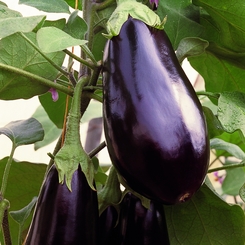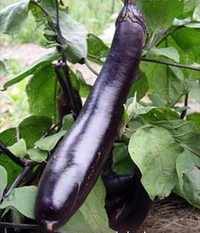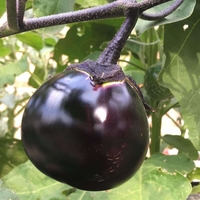Owing to the screen size of your device, you may obtain a better viewing experience by
rotating your device a quarter-turn (to get the so-called "panorama" screen view).
|
This page updated for 2022.
|
Click here for the site directory.
|
|
Please consider linking to this site!
|
Click here to email us.
|
Eggplant
(Solanum melongena)
Cultivars

Eggplant is renowned primarily not so much for its own rather mild taste but for its amazing ability to soak up any oil or fat like a sponge and taste of that oil. Of the “kraft-paper-substitute” vegetables, it is far and away the noblest, and we like to grow a bit. Our short-season climate, however, makes that a dicey proposition with this long-growing, very frost-tender vegetable; so it is essential (as we know from bitter experiences) that we grow a short-season variety.
That said, the “days to maturity” datum becomes especially critical because, unlike some other warm-season crops, eggplants have almost zero tolerance of cold (other plants may be checked in their growth by a cool spell, but eggplants tend to just give up), so their growing days have to be definitely warm growing days, somewhere right in the middle of our so-called “warm season”, which is not a very long period.
Nominal eggplant DTM (“days to maturity”, from transplant, not direct seeding) tend to run from 60 on up to 80 or even more. We reckon that even as short as our summers are, we should, if we pick our transplant day carefully, be able to grow eggplants with “days to maturity” of up to 70—maybe even 75, but that would probably be pushing the envelope. (Note that all published eggplant DTM (“days to maturity”) figures are from date of transplanting.)
We will now skip over the details of the many hours we put into scouring non-seedsman information on eggplants and jump to our conclusions. There are, to greatly over-simplify, two main categories of eggplant: those of the “traditional” ovaloid shape (usually but not invariably dark purple), and the “Oriental” long, thin types (same color comments).
For a classical eggplant, we feel you can do no better than the Italian hybrid Traviata (that’s it at the upper left); there are other more or less competitive types, but they average about 70 DTM—Traviate is 60 days (and maybe a tad less). That makes our eggplant-growing safer as regards seasonal temperatures, plus it adds 10 days or so to our growing season. It is very widely available as seed, and, better yet, as transplant slips. We’ve been growing it for a few years now and have no plans to change. But…if you just cannot abide hybrids, the clear alternative for this sort is Diamond, whose oval, dark-purple fruits run to about 7" in length; its claimed DTM are 70 or a bit over.

For an Oriental type, the best bet seems to be the open-pollinated Kurume Long (that’s it at the right); numerous gardeners have commented most favorably on its qualities (notably, to us, its flavor and texture). The eggplants tend to be 9" to 10" long. It is listed by a major Oriental-seeds specialist house as 60 to 80 DTM, but other sources tend to report 60 to 75, so it should work fine in our climates. We haven’t tried it because most—well, all—of our culinary eggplant needs are for the classic style. We have seen only one place offering it as transplant slips, so you may have to sow seed yourself. There are a few other decent-looking candidates for this type, but those are all hybrids, yet offer no obvious advantage over Kurume.

One other variety of possible interest is the globular type Kamo (that’s it at the left). This is an open-pollinated Japanese “gourmet” eggplant; it is typically about 4 inches in diameter. It is of interest because it is an heirloom considerd a gourmet delicacy in Japan. It has a reasonable 65-75 DTM, so it might be well worth trying.
Finding eggplants as transplant slips is easy for some and sheer drudgery for others. The Oriental types cited here are the hardest to find (though we have seen them offered). For seeds of those Asian types (if you just cannot locate transplant slips), try Kitazawa Seed.
Planting
Timing
Owing to the nature of eggplant’s climate demands, as just discussed, timing in our relatively short but hot season is crucial. Obviously, seedlings for transplant is the only possible approach. The question of when to plant out is not terribly tricky: we want the soil temperature to have risen to about 65°. In our climate, the daily average air temperature reaches 65° right around June 1st, which by good luck is also about the time that soil temperatures roughly equal air temperatures.
Starting Seedlings
The harder part is figuring on when to sow seed indoors to prepare seedlings for transplant. In general, eggplants need a lot of pre-transplant development time; but exactly how much “a lot” should be varies significantly from source to source. There are recommendations out there ranging from (for a June 1st transplant date) starting as early as February 1st—four months!—to as late as April 20th.
It is generally accepted that eggplants will germinate in one to two weeks from sowing. We suspect that starting 8 weeks in advance will probably work—that would be April 6th—but we won’t swear to that date.
Indeed, this is one of those cases where seedling preparation is such a drag that it makes sense, if your pocketbook or wallet can possibly take it, to buy potted eggplant slips. There are enough respectable seed sellers offering between them a good number of varieties at, typically, a few dollars per plant. We confess that that is how we go, and the results have been fine for three years running and we will continue this season. If you order slips online, make sure that you set a delivery date somewhere from middle to late May (that allows a week or so prior to June 1st for hardening off the potted slips prior to actually putting them in the ground).
If you opt to do it yourself, optimum soil germination temperature for eggplant seeds is 86° F. Even after emergence, maintaining a soil temperature of about 70° is recommended. It is wise to start more seeds than one wants plants, then select the strongest seedlings at planting-out time. Note again that actual germination is famously slow, often up two weeks.
The Bed
A well-drained sandy loam of pH 5.5 to 6.5 with high organic matter content is ideal for growing eggplants.
By general report, plastic mulches are a huge assist in growing eggplants in a shorter-season area.
One can also grow eggplants in containers, needing one five-gallon container per plant.
Transplanting Out
We have already discussed planting dates. Note that in mid-June average night temperatures are only in the middle to high 40s. These rascals being so cold-sensitive means that we need to muster all the warmth weapons in our arsenal: plastic mulch to warm the ground, put in place at least a couple of weeks before transplant time; row covers; and perhaps Walls o’Water (or makeshift substitutes, like plastic milk jugs filled with water and set amongst the seedlings).
A plant spacing, in deep-dug beds, of about 18 inches probably works best, though somewhat closer spacings might be risked, especially for the smaller varieties. Or, as noted, containers work well.
It’s especially important to water eggplants well right after transplanting, because—besides temperature—eggplants are also quite sensitive to water stress. (That’s why drip irrigation is a wise approach.)
Growing
Water well; as noted above, drip irrigation works nicely for eggplants. Some occasional side dressings of extra fertilizer are often recommended, but beware: too much nitrogen will produce lush foliage but few fruits.
Although eggplants are sturdy bushes, the fruits are heavy: support of some sort for them is a wise idea. Make quite sure that none of the fruit is in contact with the ground (or the mulch surface); use something to keep any drooping or sagging fruit up—perhaps a brick, or even a plastic coffee-can lid.
Fruits should be picked as they come ready, judged by their size. If the season lasts long enough, the plants will continue producing. Harvest by cutting the stems—don’t pull the fruits off. And be aware that many eggplant types have spiny stems, so have a care (or wear gloves). Also be aware that all green parts of the plant can be toxic—don’t try eating the leaves! After all, these are part of the nightshade family. Bitterness, a too-common complaint with store-bought eggplants, seems rare in home-grown, probably because they are picked before getting too big (a word to the wise). In fact, let’s emphasize that: don’t let eggplants get too big before picking them. How big “too big” is depends on the cultivar, so read up and (as Nero Wolfe often puts it to Archie) use your intelligence as guided by your experience.
Note well that eggplant has to be used quickly after harvest: even under ideal storage conditions (temperature 40° to 50° F. and humidity near 85%), the fruit will keep only about seven to ten days. Your best bet is to cook it up in appropriate dishes then freeze those cooked dishes for later use.
More
Relevant Links
Besides any links presented above on this page, the following ought to be especially helpful:
Odds and Ends
Biology
Eggplant is a frost-intolerant perennial grown as an annual; it belongs to the family Solanaceae, which also includes tomatoes, peppers, and potatoes (and the nightshades). The purplish-black color of the immature fruit is a result of anthocyanin in the subepidermal cells.
Fruit types are varied, including a small “green grape” eggplant from Thailand, “Easter-egg” types with variously colored fruits on a single plant, Italian “bella” types with delicate pink and white shading on round fruits, the standard commercial black type with three-pound fruits, and the increasingly popular, slim, purple-black Oriental (“Japanese”) types. Shapes vary from round to almost breadstick-shaped; color variations include white, red, green, purple, pink, glossy solid black, and variegated.
History
Eggplants are first reported as being in cultivation in China in the early 4th or 5th centuries B.C.; the dark-purple varieties were probably being domesticated in Burma and India at around the same time. They were cultivated in Japan at least as early as the 8th century, during the Tang dynasty. They likely made their way to Europe with the Moors in Spain somewhere between 300 and 700 A.D.
“Aubergine”, the name by which eggplants are known through most or all of Europe, is French, and comes comes from the Catalan alberginia, which in turn comes from the Arabic al-badingan. It was the English who dubbed the vegetable “eggplant”, from the egg-like shape of the first specimens introduced to that country (which may even have been white).
Envoi
A popular eggplant recipe from Turkey is called “Imam bayildi” (with variant spellings seen), which means, roughly, “the swooning priest” (an imam is not actually a priest but a Muslim prayer leader, but that’s too long a phrase). Explanations of the name are several—the imam swooned when he tasted how good it was; the imam fainted when he saw how much expensive olive oil was used; the imam was delighted when a shopkeeper’s wife was required to quickly prepare a dish for the imam’s unexpected visit—or an old Turkish proverb (Imam evinden ash, olu gozunden yash cikmaz, “No food is likely to come out of the imam’s house and no tears from a corpse”) suggests that perhaps the stingy imam, presented with a dish so expensive, fainted from delight. (Adapted from a text by Clifford A. Wright.)
Return to the top of this page.
If you find this site interesting or useful, please link to it on your site by cutting and pasting this HTML:
The <a href="https://growingtaste.com/"><b>Growing Taste</b></a> Vegetable-Gardening Site
—Site Directory—
Search this site, or the web
-
Background Information
about the purposes and design of this site
- Site Front Page
-
Introduction

- An Apologia: why one should cultivate one's garden
- Deep-Bed Gardening (forthcoming)
- Container Gardening (forthcoming)
- Vegetarian and Organic Considerations (forthcoming)
-
Recommended Crops for a home garden, by variety
-
Gardening information and aids
-
Miscellaneous Information of interest to the home gardener
Since you're growing your own vegetables and fruits, shouldn't you be cooking them in the best way possible?
Visit The Induction Site to find out what that best way is!
|
If you like good-tasting food, perhaps you are interested in good-tasting wines as well?
Visit That Useful Wine Site for advice and recommendations for both novices and experts.
|

|
This site is one of The Owlcroft Company family of web sites. Please click on the link (or the owl)
to see a menu of our other diverse user-friendly, helpful sites.
|
|
 Like all our sites, this one is hosted at the highly regarded Pair Networks,
whom we strongly recommend. We invite you to click on the Pair link for more information on getting your site or sites hosted on a first-class service.
Like all our sites, this one is hosted at the highly regarded Pair Networks,
whom we strongly recommend. We invite you to click on the Pair link for more information on getting your site or sites hosted on a first-class service.
|
|
All Owlcroft systems run on Ubuntu Linux and we heartily recommend it to everyone—click on the link for more information.
|
Click here to send us email.
Because we believe in inter-operability, we have taken the trouble to assure that
this web page is 100% compliant with the World Wide Web Consortium's
XHTML Protocol v1.0 (Transitional).
You can click on the logo below to test this page!
You loaded this page on
Friday, 18 April 2025, at 21:57 EDT.
It was last modified on Wednesday, 26 January 2022, at 01:54 EST.
All content copyright ©1999 - 2025 by
The Owlcroft Company



